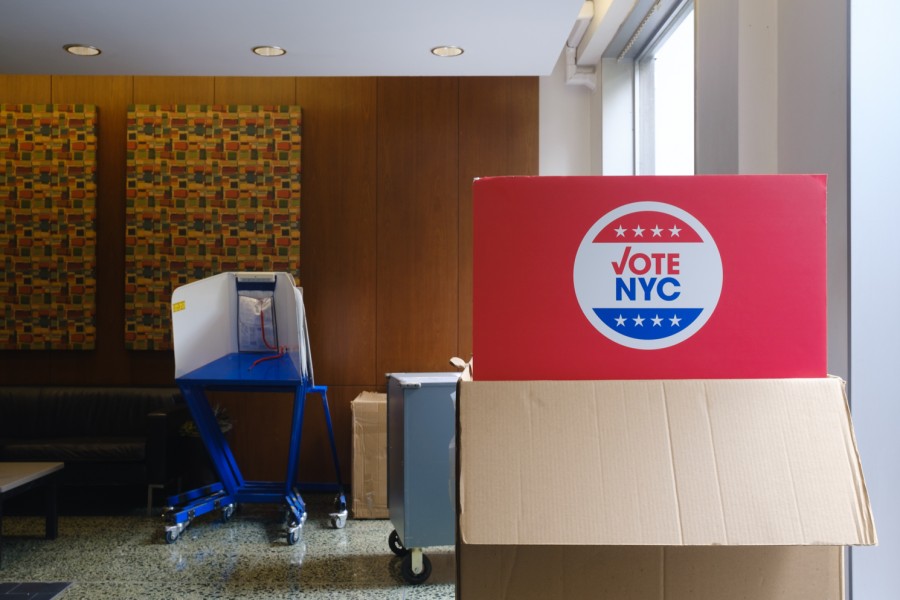A guide to voting in this year’s midterm elections
Election Day is less than two weeks away, and early voting begins this week. Get to know New York’s candidates and prepare to cast your ballot with WSN’s midterm voting guide.
A polling site in New York City. (Samson Tu for WSN)
October 27, 2022
Early voting for New York’s midterm elections begins on Saturday, Oct. 29, and New Yorkers are preparing to cast their ballots for several consequential races ahead of Election Day on Nov. 8. WSN compiled a guide on the candidates running for governor, issues that will appear on the ballot and how to vote in the upcoming election.
How to vote in New York
Early voting will continue through Nov. 6, and voters can also visit their polling location in person on Election Day. Assigned early voting locations may differ from Election Day voting locations, and voters can find their poll sites by visiting the New York State Board of Elections website. Polling locations will be open between 6 a.m. and 9 p.m. on Election Day. Early voting hours vary by location.
Voters are not required to bring an ID to vote unless a form of identification was not submitted at the time of registration.
Get to know the New York candidates
Voters can view their ballots ahead of time on the New York State Board of Elections homepage, and find their congressional district through The Washington Post’s online resource. Republican candidates have gained momentum in several races, despite New York being considered a Democratic stronghold.
Incumbent Kathy Hochul and Rep. Lee Zeldin are competing in the race for governor. The candidates participated in their first and only debate on Tuesday, Oct. 25, sparring over crime policy, abortion, economic revitalization, the 2020 election and COVID-19. Polls show an increasingly close race between the two.
Hochul, a Democrat, replaced Gov. Andrew Cuomo in August 2021. Leading up to the midterm election, Hochul has announced a series of policies to address crime — specifically on the New York subway. On Oct. 22, the governor announced that more police officers would be added to the system. She has also allocated additional state funding to local law enforcement. Reproductive justice and COVID-19 safety have been at the forefront of her campaign as well.
Zeldin has served as the representative of New York’s 1st District since 2015, and worked closely with former President Donald Trump while in office. He has focused his campaign on bolstering the economy, implementing stricter crime policies and reducing taxes. He has left housing, healthcare and climate change largely unaddressed.
Candidates for New York State attorney general, comptroller, state senator, lieutenant governor, one U.S. senator and one U.S. representative will also be listed on the ballot.
Issues on the ballot: Climate change, racial equity and the “true cost of living”
Four proposals will appear on the ballot, in which New Yorkers can vote in favor or against. The first — the Clean Water, Clean Air and Green Jobs Environmental Bond Act of 2022 — would allow New York state to sell as much as $4.2 billion in bonds to mediate climate change’s impact on the environment. The money would fund climate resiliency measures, investment in clean energy and natural restoration projects.
The second proposal would add a mission statement to the New York City Charter’s preamble, advocating for “a just and equitable city for all.” The preamble would also include a statement detailing the city’s responsibility to address “past and continuing harms” by examining and revising its “foundations, structures, institutions and laws to promote justice and equity for all New Yorkers.”
If the third proposal were to pass, the city would create an Office of Racial Equity and hire a chief equity officer to form racial equity plans, which would be re-released every two years with the goal of addressing racial disparities across the city. The office would collect data and communicate with agencies, services and communities in the city. A Commission on Racial Equity, which would be appointed by elected officials, would also be established in order to develop the racial equity plans.
The final proposal would require officials to track the “true cost of living” in New York City, including the cost of housing, food, childcare, transportation and more. The “true cost” would not include public or private assistance. The city government would be responsible for releasing this data annually.
Voting in another state’s race
If individuals are registered to vote in a different state, they can vote in their home state by submitting an absentee ballot at a polling site in New York or by mail by Nov. 8. Voters can verify how to submit their ballots according to their state’s protocols at Vote.org, and can track the status of their absentee ballot once submitted through the Board of Elections website.
Contact Connor Patton at [email protected].


























































































































































